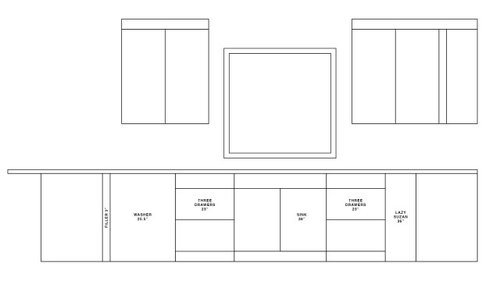
Spacing Criterion = Spacing ÷ Mounted Height In this case, you just need to use the same formula to calculate the spacing criterion rather than the spacing itself. This will save you a lot of money versus drilling new holes in your walls to fix the problem. Fortunately, you can correct this by putting new fixtures into the recessed holes that have a different Spacing Criterion. In this section I will discuss what to do if you already have recessed lighting installed, but the recessed lighting spacing is wrong. What if I Already Have Lighting Installed? Unfortunately, the term “mounted height” is misleading, but that is the standard term. This will be the case for anything that you wish to illuminate, from tabletops to counters or coves in which you intend to place artwork.

In this case, you need to calculate the spacing based on the distance between your table and the ceiling, not the floor and the ceiling. In one area of your kitchen, you want to be illuminating a table, not simply the floor. Let’s take another example, this time including a surface. Since the honeycomb layout is composed of triangles, this will not be an issue. If you are using a grid layout, you will want to make sure that the diagonal of the squares of your grid are less than 5.6 feet apart, not the sides of the square. If your lighting is arranged in a grid like these tennis balls, the maximum distance calculated is on the diagonalThis is especially important if you are using a grid layout for your recessed lighting, rather than a honeycomb layout (I discuss the difference in my article about choosing a recessed lighting layout. Note that this is the maximum amount of recessed lighting spacing you should have between your light fixtures, not necessarily a minimum.

In this case, your spacing would be the following: Your recessed lighting fixtures have a spacing criterion of 0.7 and you are planning to light from an eight foot ceiling. The formula to use is the following:Spacing = Spacing Criterion * Mounted Height In that case, you need to do some calculations. However, it is not simply telling you the maximum number of feet to place between your recessed lighting. This number gives you the ratio for the maximum distance between two light sources. This will usually be a number between about 0.5 and 1.5. When purchasing your light fixture, look for the “Spacing Criterion”, “SC”, “Space to Mounting Height Ratio”, “S/M Ratio” or “S/M”.

Fortunately, manufacturers of recessed light fixtures usually do this work for you. Unfortunately, unless you have access to the light fixtures themselves as well as to a light meter, you won’t be able to calculate this number. Whatever size fixture you choose, I would say keep all 10 the same.Calculating the appropriate spacing is really only a matter of using a single formula.The most important number for calculating your recessed lighting spacing is the Spacing Criterion (SC). Keep the spacing the same (4ft on center) all the way down the length of the room and then I think your layout will work just fine. and so that the layout doesn't look haphazard, and most of all, so that you don't need to structurally alter the joists.ĭon't fret over the corner of the room and how it affects the symmetry of the lighting. This keeps all the lights evenly spaced all the way down the room so that the cone of light is evenly distributed. That would mean you would have a light between: Place an X where each can light would be if they were on 4 ft centers. If we assume your joists are 16" on center all the way across the room, take a piece of graph paper and mark each line with a measurement, in inches, to represent your joist layout.Ġ, 16, 32, 48, 64, 80, 96, 112, 128, 144, 160, 176, 192, 208, 224, 240, 256, 272.

the lights do not need to be symmetrical as if each room was its own rectangle. LOLįorget about the shape of your room for a minute. Unless you like the feeling of being under a heat lamp. More lights, while using a smaller wattage bulb usually results in a more natural, even dispersion of light than having less lights and more wattage. since the ceilings are 8ft, I might suggest 5". You can plan it however you like on paper, but when you open up the ceiling and find that a joist is in your way, you are going to have to change something.Īside from the large space between the 6 lights and the 4 lights, your layout might be fine on paper, but probably will not work in the real world. your layout is going to have to miss the joists.


 0 kommentar(er)
0 kommentar(er)
